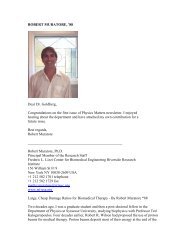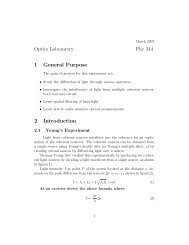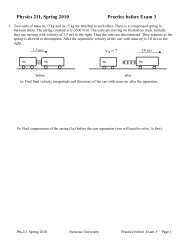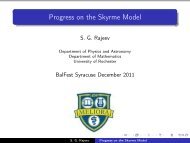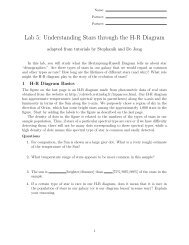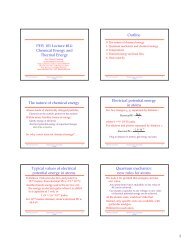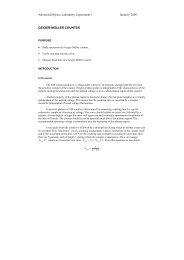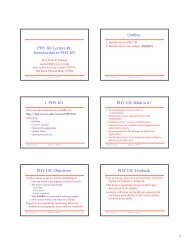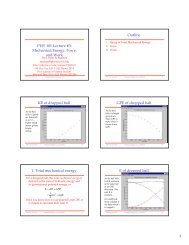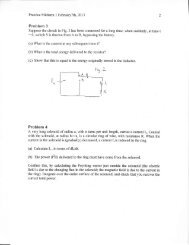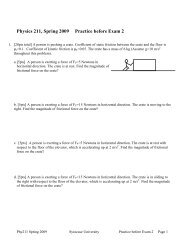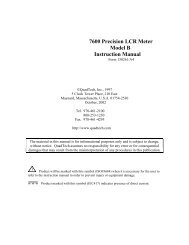Volume 5 - Physics - Syracuse University
Volume 5 - Physics - Syracuse University
Volume 5 - Physics - Syracuse University
You also want an ePaper? Increase the reach of your titles
YUMPU automatically turns print PDFs into web optimized ePapers that Google loves.
3<br />
50 years of Arny Honig continued<br />
marathons, the 4 a.m. phone calls – “I want to know the results!” – the flood of words and ideas, the contagious energy and<br />
raw power of Honig’s personality, with equal parts awe, gratitude, and pride that they survived years working with him.<br />
“Arny almost killed me,” says Xiangdong Wei (G’94), who spent 10 years in Honig’s lab, first as a doctoral student, then<br />
post-doc. Their collaboration has continued another decade, as Wei moved with his nuclear target experiments and gear from<br />
Honig’s lab to Brookhaven National Laboratory on Long Island, then Thomas Jefferson National Lab in Virginia.<br />
“Sometimes, you wanted to hate him,” Wei says of Honig. “But you couldn’t. You had to love him.”<br />
Born in the Bronx and educated at Cornell and Columbia <strong>University</strong>, where he earned his Ph.D.,<br />
Honig came to SU in 1956 after post-doc stints at Berkeley and in Paris. He came because he could<br />
set up his own lab and because no group was yet working in his specialty – low-temperature solidstate<br />
physics. He wanted to run his own show.<br />
“This was hot times for solid-state transistors and electronics,” Honig says. “And we were right at<br />
the frontier.” He and fellow SU physicists Henry Levinstein and Mel Lax were in the first wave of scientists exploring the<br />
behaviors of atomic particles and how these manifested in the properties of certain solids, including silicon. As the field<br />
grew it broadened to include other states – liquids, gels, crystals – and was renamed condensed matter physics.<br />
Honig’s lab grew, too. He went from one room with a grad student or two in the basement of Steele Hall to five rooms and<br />
as many as 10 associates under the old Archbold Stadium and in the new <strong>Physics</strong> Building. Government and foundation<br />
grants grew from thousands to hundreds of thousands of dollars. Honig’s group was doing the basic science – solving problems,<br />
building equipment, conducting experiments – that would lead to major developments in computer (semiconductors),<br />
medical (NMR and MRI) and nuclear (fusion and fission) technologies.<br />
They built some big machines to do it.<br />
“We had to cut holes in the ceiling and dig pits in the floor” to make room for a massive dilution refrigerator and its attendant<br />
superconductor magnets for experiments with polarized hydrogen deuteride (HD). When a bigger experiment<br />
required more polarized HD, they built a bigger machine, and cut bigger holes and dug deeper pits.<br />
“I always liked big machinery,” Honig says, and chuckles.<br />
His deep voice still echoes the broad, nasal tone of the Bronx. And while he stays current with the small-scale physics of<br />
today, the nanotechnology, nanostructures, and nanoexperiments – “You can do four or five experiments on a countertop!”<br />
– Honig is glad he was part of the outsized “cowboy physics” era, “when we were hanging from ladders at 4 a.m.<br />
and jamming hot rods<br />
into blocks of ice to<br />
break them.”<br />
He has won the admiration<br />
of his colleagues<br />
for his commitment to the field, loyalty<br />
to students, and enthusiasm for pursuing pure<br />
science at its deepest levels.<br />
“He’s just a guy who is 100 percent committed<br />
to doing interesting science,” says Eric Schiff, a<br />
professor in SU’s physics department for 29<br />
years. “I’m sure that the day he dies, he’s going<br />
to write down his next possible Nobel Prizewinning<br />
idea.”<br />
Don’t let his Emeritus status fool you. At 82,<br />
Arny Honig is far from done.<br />
“I still have some very interesting experiments<br />
I’m planning to do,” he says. He could use a<br />
grad student or two. “Oh, I’ve got some ideas,”<br />
he says, nodding and smiling.<br />
Sitting there in Honig’s small, book- and paperstuffed<br />
office in the <strong>Physics</strong> Building, you<br />
could almost hear generations of grad students<br />
sigh.<br />
James Reilly, freelance writer. To appear in the fall<br />
issue of Arts & Sciences, the college’s new alumni<br />
magazine.




